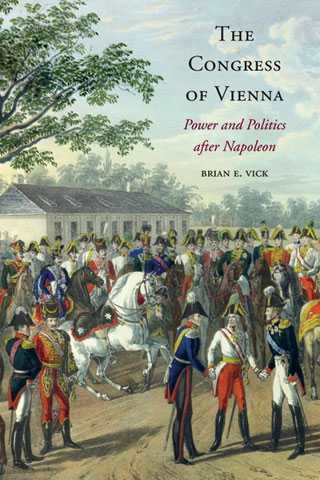
November 1, 2016, by Mike Heffernan
Reading Group: Brian Vick’s ‘The Congress of Vienna’
- Brian E. Vick, The Congress of Vienna: Power and Politics After Napoleon (Cambridge, Mass.: Harvard University Press, 2014)
The project team met for a regular reading group discussion, this one focused exclusively on a fascinating new book on the Congress of Vienna by Brian Vick, an American historian from Emory College in Atlanta, Georgia. Vick is an expert on modern Germany and central Europe during the period historians like to call the ‘long 19th century’ but he has even wider interests in intellectual and cultural history. His first book, Defining Germany (2002), also published by Harvard, was an ambitious attempt to chart how an inchoate modern German identity was conjured into being after the 1848 Revolutions through a potent mixture of nationalism, liberalism and historicism, to be sure, but with an ultimately disturbing undercurrent of racial theorising already strongly to the fore. This is an important argument that successfully demonstrates how biological and racial forms of German nationalism long pre-dated the emergence of Darwinism after the 1860s.
In his latest book, Vick turns his attention to the Congress of Vienna, one of the ‘blockbuster’ international conferences that have punctuated European history since the mid-17th century against which subsequent international assemblies have benchmarked themselves. The Congress of Vienna sought to establish the conditions for a durable peace after more than two decades of general European warfare initiated by the French Revolution and the rise of Napoleon. The Congress began in the autumn of 1814, effectively in September although proceedings officially commenced only in November. The work, if it can be so construed, continued until June 1815, despite the spectacular resumption of hostilities after Napoleon’s return from exile in March 1815. The final act of the Congress was signed more than a week before the Battle of Waterloo, an event that could easily have rendered the entire exercise completely redundant.
In contrast to conventional analyses that focus on the grand strategies of Talleyrand, Metternich, Castlereagh and Wellington, Vick focuses on the quotidian experiences of Viennese conference life. In so doing, he provides a very useful historical context for the approach we are adopting in the Conferencing the International project. While considering previously overlooked aspects of the Congress negotiations, including those involving the rights of European Jews, the abolition of slavery, and the eradication of North African piracy, Vick provides a richly textured account of the often frivolous lifestyles of the hundreds of European diplomats, dignitaries and grandees who assembled in the Austrian capital, many accompanied by large entourages that included family members, advisers, clerks and dozens of servants. This expanding assembly was serviced throughout the Congress by an army of hoteliers, restauranteurs, and general hangers-on who provided the accommodation, food and entertainment.
As Vicks brilliantly reveals, the Congress needs to be understood not only through its geopolitical outcomes but also in terms of its social and cultural activities. These activities were more significant than has previously been acknowledged for the political credibility of the Congress ultimately rested, Vicks suggests, on how the proceedings were presented to an increasingly enfranchised European public in whose name the delegates claimed to negotiate. Although the Congress was enacted by European aristocrats, the guardians of traditional political and religious authority, and sought to re-create a conservative monarchical order across the continent, it had to address the demands of an emerging urban-industrial bourgeoisie which retained more than a vestigial commitment to the revolutionary republican ideals unleashed after 1789.
The Congress became, therefore, a self-consciously stage-managed exercise based on a performative visual culture that sought to communicate to a large public sphere. Constituencies previously entirely overlooked by historians, particularly women, played a central co-ordinating role in selling the Congress, literally in the form of the many prints, trinkets and other mementos that allowed this great epoch-defining event to be miniaturised and domesticated on the walls and mantelpieces of familial sitting rooms and salons.
The significance of this important book seems obvious to our project, and highlights the need to widen the scope of our deliberations to consider what might be called the ‘marketing’ of the interwar conferences we will be considering. This will be more relevant in some cases than others, but hopefully some of the archives will allow this dimension to be explored.
No comments yet, fill out a comment to be the first

Leave a Reply